Reopening of the Historic Stilwell Road shall be a game-changer for landlocked northeastern India, offering unparalleled international business and trade opportunities. This 1,736 km road, stretching from Lekhapani in Assam to Kunming in China, passes through Myanmar, connecting three countries and their economies.
The Government of India’s Act East Policy, a revival of the erstwhile “Look East Policy,” aims to boost economic ties with Southeast Asian nations. Reopening the Stilwell Road aligns perfectly with this policy, promising to:
Enhance Trade: – Facilitate the exchange of goods and services between India, Myanmar, and China, benefiting local economies.
Foster Economic Growth: – Create new business opportunities, stimulate economic development, and improve living standards in northeastern India.
Promote Cultural Exchange: – Strengthen people-to-people ties between the three nations, enriching cultural understanding and cooperation.
Strategic Significance:- Enhance India’s strategic influence in the region, while bolstering ties with neighboring countries.
People in North East India have long advocated for the reopening of the Stilwell Road, recognizing its potential to transform the region’s economy and connectivity. With the government’s support, this historic road can once again become a thriving artery of trade and cultural exchange.
Background of Construction:-The Stillwell Road is also known as Ledo Road as it starts from Ledo was built during World War II, so that Western Allies could supply the Chinese counterpart as an alternative route to the Burma Road which was cut off by the Japanese in 1942. The same road was renamed as Stillwell Road, christening General Joseph Warren Stillwell of the U. S. Army in early 1945.
Chinese nationalist military commander Chiang Kai-shek laid first proposal to rechristen the road in the name of General Stillwell. Starting from Tinsukia district of Upper Assam the road passes through the Burmese towns of Shingbwiyang, Myitkyina, Bhamo of Kachin state.
In the 19th century British railway builders had surveyed the Pangsau Pass which is 3,727 feet (1,136 m) high on the India-Burma(near Changlang/ Arunachal ) border, on the Patkai crest, above at Nampong at Changlang District of present Arunachal Pradesh.
They concluded that a track could be pushed through to Burma and down the Hukang Valley. Although the proposal was dropped, the British garrison engineer had planned the Patkai Range for a road from Assam into Northern Burma.
In order to curve out a road amidst the jungle terrain, British engineers had surveyed the route for first eighty miles. After the British had been pushed back out of most of Burma by the Japanese, American soldiers had shouldered building this road became a priority for the United States.
Beginning of the construction:-Construction work started on the first 103 mile (166 km) section of the road in December 1942, followed a steep, narrow trail through territory from Ledo, across the Patkai Range through the Pangsau Pass, nicknamed “Hell Pass” for its challenging difficulty, down to Shingbwiyang, Burma.
Topographical & Engineering Parameters: – Uneven terrains of Patkai mountain range, on the construction site raises as high as 4,500 feet (1400 m), the road required the removal of earth at the rate of 100,000 cubic feet per mile (1800 m³/km). Steep gradients, hairpin curves and sheer drops of 200 feet (60 m), all surrounded by a thick rain forest was true test for this first section. However, first bulldozer reached Shingbwiyang on 27th December 1943, three days ahead of schedule.
Annexation to China: – Work continued through 1944 in late December it was opened for the transport of logistics. In January 1945, four of the black Airborne Engineer Battalions (along with three white battalions) continued working on the now renamed Stilwell Road, improving and widening it. Indeed, one of these African American units was assigned the task of improving the road that extended into China.
Connection of NH -153 with Stillwell Road: –National Highway 153, which connects Lekhapani of Tinsukia district, ends at Jayrampur of Changlang district, which is said to be the last leg of Indians National Highway is a small fraction of the Stilwell Road.
Stillwell Road in Post War period: –As soon as the World War II was over the road left abandoned by the Government of India. Neither the Indian Government nor the Burmese government took initiative to repair the road.
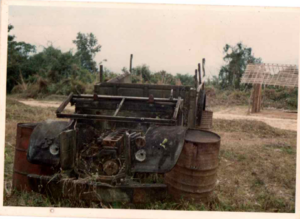 Witness Of World War II: – Remaining of 4×4 American War Jeep kept standing near the bank of Lake of No Return on Stilwell Road.
Witness Of World War II: – Remaining of 4×4 American War Jeep kept standing near the bank of Lake of No Return on Stilwell Road.Photograph by – Pranab Kumar Gogoi
Visit European Traveler after Independence:-
- In 1955 few members of the Oxford-Cambridge Overland Expedition, as a part of Oxford and Cambridge Far Eastern Expedition flew from London and started expedition from Ledo of Tinsukia district and they followed the road from Ledo to Myitkyina. This travel experience was recorded in their travel chronicle; First Overland by Tim Slessor (1957), he was could not complete the journey as a major bridges was found completely damaged in the section between Pangsau Pass and Shingbwiyang.
- In February 1958, another Londoner, oriental explorer, author of travel book, The Impossible Takes a Little Longer, Eric Edis, drove his famous Land Rover, the on Ledo Road from Ledo of Tinsukia District to Myitkyina of Myanmar and finally reached Rangoon.
- Long after the Japanese surrendered and World War II ended, foreigners continued to visit the region, Until the 1960s, foreigners used to come regularly by [Stilwell] road. After 1972, the government stopped foreigners from moving beyond Jairampur. Since no traffic movement is permitted by both sides, hence the road has been swallowed up by jungle and swampy eath, which is barely negotiable on foot.
Policy of Government of India on Stillwell Road:-
- For many years, travel into the region was also restricted on account hibernation of an active insurgent outfit of Assam in India and along the frontier against the Government of India. It was alleged that, after committing crime in India, the rebel elements skids to the territorial land of Myanmar, to avoid aggression from Indian Armed Forces.
- There are claims from intelligence organization that Indo Myanmar Frontier adjacent to Myanmar is dominated by insurgent outfits. In reality there is only two major insurgent groups active in the area, namely NSCN(K) and Ulfa active in that frontier.
- On its contrary in Manipur frontier there are 36 militant outfits are active, knowing it completely India Government had opened the Tamu – Morae Road connecting India and Myanmar.
- Construction of Stilwell Road was only possible, across chopping off the jungles amidst the dense rain forest of Patkai foothills in order to support China during World War (II).
- However post Indo China War, the scenario is completely changed. Indian adapted defensive foreign policy with China, and kept Arunachal out from the red bull eyes of Red Army. Hence India Government adapting the policy of none developing of road infrastructure, so that it enemy will face hostile situation to drive towards the main land. Subsequently central government, supported this stance of the Indian Army, continued to adhere to this policy of leaving Arunachal Pradesh and its roads undeveloped.
- India imposed harsh restrictions between 1962 and the mid-1990s on travel into Burma which also applied to outsiders. So practically road is barred from use by the Government.
- Nidhi Srivastava, Additional Deputy Commissioner (ADC) of Jairampur of Arunachal Pradesh, explains that, for the Indian government, the Northeast has always stopped at Assam.
- Pandit Jawaharlal Nehru had this fear, “if we construct roads here, the Chinese might come in.”
- Srivastava cited that this policy continued until 2007, when, suddenly, a lot of money were pumped in” by the Central government.
- Then Finance Minister P Chidambaram in his budget speech for 2013-14, outlined government plans to solicit millions of dollars from the World Bank and the Asian Development Bank, “to build roads in the Northeastern states and connect them to Myanmar”.
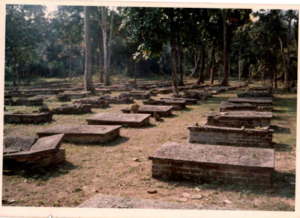
Present Condition of Stillwell Road:-
- In recent years, the Burmese government has focused on the reconstruction of the Ledo Road as an alternative to the existing Lashio-Kunming Burma Road. The Chinese government completed construction of the Myitkyina-Kambaiti section in 2007 and the Rangoon based Yuzana Company is constructing the section between Myitkyina and Tanai.
- The National Highways Authority of India was awarded responsibility for transforming India’s portion of the Stilwell Road into a four-lane motorway that can be relied on for increasing trade and transportation.
- The Burmese Army doesn’t want the representatives of the Border Roads Organization or the NHAI involved in the construction of the road; only civilians, therefore ca private Construction Company was entrusted to build the Indian portion of road.
- Small group of migrant labour from Assam, UP, Bihar and Jharkhand have been brought in to work on the refurbishment and expansion. But the reconstruction was not complete and perfect to the mark.
- Unfortunately durability of this road, however, depends entirely on the monsoon, which usually starts in March, and this rainy season last for lasts for six months in average every year, and can be torrential, washing away chunks of tar in a single downpour. This makes it all the more impressive to think it took only three years to complete the original Stilwell Road, considering the unfriendly topography, temperamental climate and the lack of heavy machineries.
- A portion of Stillwell Road connection between Eastern Burma and South China, it is a four lane international highway, hence onwards, Stilwell Road that runs past allowing for a smooth ride through the town traversing through South Asian Countries.
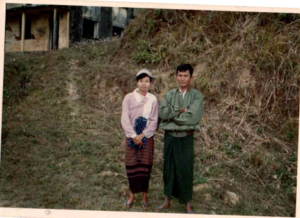
Demands to reopen Stillwell Road
Accounts of General J. J. Singh:-It can be recalled that, retired General and former chief of Indian Army and erstwhile Governor of Arunachal Pradesh, pushed hard at Delhi for the re construction for Stillwell Road, in order to expedite border trade and traffic with Myanmar and China .
Retired General Further argues that, “China has developed its part of the Road. They are helping Myanmar to develop its bit of road, so there is no point for India for not developing its own part of the road. General J. J. Singh addressing at National University of Singapore on India’s Look East policy says that Arunachal Pradesh is hosting 27 kilometer of this total length of the road. Only 61 kilometer of this road passes through India. Burmese and Chinese people will be able to reach India, in any case Myanmar part of the road is opened.
Role of Student organization of Northeast :- Student organization like North east Student Union, All Assam Student Union, Citizen’s Forum, Social Groups, Business Houses, Intellectuals, Local Politicians of Northeast upbeat about proposals to revive Stillwell Road and to take up the matter with Burmese Government.
Need of repair road segment between Pansu Pass and Myitkyina:-If diplomatic dialogue between Government of India and Myanmar Government takes initiative connecting between the portion of Northern Myanmar’s Myitkyna to Pangsau Pass (nicknames Hell Pass), situated near to Chnglang District of Arunachal Pradesh, then this connectivity of 312 Kilometer stretch shall reopen the new gate way to the South East Asia.

Geographical distance of some South Asian city from Ledo (Assam) in miles:-
Ledo(Assam/ India) —————0 mile
Shingbwiyang (Burma)————103 mile
Warazup(Burma)——————–189 mile
Mytikyiana(Burma)—————- 268 mile
Bhamo(Burma)———————–372 mile
Wanting(Burma)———————507 mile
Lunfling(Burma)———————560 mile
Paoshan(Burma)———————-652 mile
Yungping(Burma)——————–755 mile
Yunnanyi(Burma)——————–876 mile
Tsuyung (Burma)———————959 mile
Kunming(South China)————–1079 mile
How reopening of road will benefit India:-
- Re opening of Stillwell Road will change the economy of North eastern India.
- Business route from Northeastern India with the countries of unexplored South East Asia will bring new initiative.
- Unemployment in North East will be solved
- Reduce the insurgency problem since unemployed youths will be engaged in works for livelihood.
- Cultural exchange will be with South East Asia and North eastern India.
- There is an immense potentiality for development of tourism along with the city standing on Stillwell Road.
- Bilateral relation of India and Myanmar will also develop with the investment for mutual growth of business and development.
- Eastern India is now a hub for production of oranges, green tea and rubber. However now problem is to find a suitable market to sell out those agro based products. It is sure that reopening of this historic Stillwell Road will make total change the total economy of Upper Assam as well as the North Eastern India.
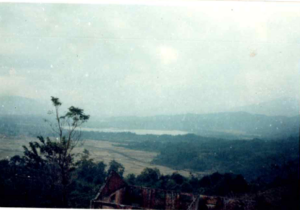
Cross Border Marriage:-Near to the Indo Myanmar, resident of both side of the border belongs to same clan and community. Opening of Stillwell Road will also open the way to legally settle the matrimonial matter of immigrants or recognizing issues related to cross-border marriages.
Reports of Indian Chamber of Commerce on Stillwell Road:-
- Study reports of Indian Chamber of Commerce, indicates that trade via renovated Stillwell Road would will cut down the transportation cost up to 30 percent for goods to be shipped between India and China .
- Former Secretary General of Indian Chamber of Commerce, NazeebArif, says that, major production hubs can come up to Northeast India and Northern Myanmar, through this road, if the road is opened and this is only possible only substantial volume of bilateral trade.
Local Trade on Stillwell Road:-At leasttwo days in a week, local border trade takes place at Pangsau Pass on Stillwell Road. Traders from both countries meet together and allowed to enter, to a certain distance, inside geographical boundary of both sides for selling of permitted goods.
How Indian Government can take initiative:-
- Government of India should immediately take up this matter with Burmese government under present “Act East Policy” as well as “Look East Policy”
- India Government should also adapt the present “Act East Policy” along with “Look West Policy” of South Asian Countries.
- During Chinese Premier Li Keqiang’s India visit in May 2013, India agreed to “explore the possibilities of the proposed Bangladesh-China-India-Myanmar (BCIM) economic corridor” with China. But New Delhi is going slow on this. When Late Prime Minister Manmohan Singh visits China this month, the Chinese counterpart had also push for the BCIM plan. China had already discussed this matter with Myanmar and Bangladesh to take this matter forward. During the tenure of Manmohan Singh’s Beijing visit, China had also offered to declare Kunming and Kolkata as sister cities to carry forward the process.
- New Delhi had some apprehension that if road is once opened than it would engulf the economy of North east, however the states of north-east wishes there should start fresh initiative for Chinese trade and investments. This trade can only boost their economy as the opening of the Stilwell Road, built during World War II, was a case in point.
- It is for your information that some business houses, bureaucrats army officials, are lobbying against reopening of this road.So it is felt that you will have to take firm steps to force and convince the ministries in Delhi for reopening this road.
Opinion of past Government of Assam: –The matter of reopening this road was pursued with Govt. of Assam few years back, than in Press Conference in a question Assam chief Minister TarunGogoi and Power and Industry Minister Mr. Prodyut Bordoloi (MLA of Lekhapani area under Margheritta LAC) informed that Burmese Government will have to come forward to repair the road falling under Kachin area of Northern Burma.
Assam’s Ex Transport Minister Pradeep Hazarika and Present Industriy Minister ProdyutBordoloi had made several appeals to Union Government, but there were no initiative from Delhi for reopening of this road.
Present Status of Stilwell Road: –Unattended and almost abandoned Stillwell Road is facing the brunt of extreme tropical weather with heavy rains and landslide causing extensive damage on the surface of the road. Uneven surface onstretchof Stillwell Well Road dominates the major portion of the road across the international border.
Bird’s eye view on condition of Stillwell Road:-
- Lekhapanito Jayrampur- (Assam Sector)- Paved Road
- Jayrampur to Nampong- (Assam Arunachal Sector)- Paved Road
- Nampong to Pangsau Pass – (Arunachal Sector)- Road riddled with rough patch [restricted for civilians]
- Pangsau Pass to Tanai – (Myanmar Sector)- Mud track
- Tanai to Myitkyina – (Myanmar Sector)- wide compacted-earth road maintained by a commercial plantation company.
- Myitkyina to China border-(Myanmar Sector)- reconstructed by a Chinese company
- China border to Kunmin – 6 Lane Highway.
Initiative of Myanmar and Chinese Government for construction of road in 21st century:-
- Burmese government, as an alternative to Lashio-Kunming Burma Road, planned for reconstruction of the Ledo Road (Stillwell Road).
- Chinese government completed construction of the Myitkyina-Kambaiti section in 2007. Rangoon-based Yuzana Company constructed the section between Myitkyina and Tanai (Danai) which was already operational from 2011.
Reports of BBC in 2010:- BBC in the year 2010, reports as such: “Much of the road has been swallowed up by jungle. It is barely passable on foot and is considered too dangerous to use by many because of the presence of Burmese and Indian ethnic insurgents in the area. At present the road from Myitkyina to the Chinese border along with the brief Indian section, situated within Assam and Arunachal Pradesh section is usable.”
Reports of South China Morning Post in 2014:-Photographer Findlay Kember, in 2014, working on a photo feature for the South China Morning Post, travelled across the three nations, to reach the entire length from three different approach of three different countries. Since international border connected to three different countries prohibits trance border movements and transportation.
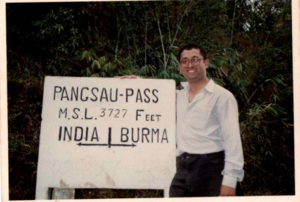
Observation of Findlay Kember on the World War II relics in Assam, Myanmar and China:-
- Stillwell Park at Lekhapani, in Tinsukia District of Assam.
- World War II War Cemetery situated between Jairampur and PangsauPass, where dead Chinese soldiers and labours were cremated.
- Nampong nicknamed “Hell’s Gate” due to treacherous malaria prone humid conditions and landslides in the area.
- World War II gas tank used as a water tank in Kachin state.
- Gravel road between Myitkyina and Tanai was very wide and well used but unpaved.
- In China, he found World War II trenches in Songshan in Yunnan province which was a site of fierce battles between Japanese defenders and Chinese attackers in June 1944, and a brass relief honoring Chinese and American soldiers in Tengchong in Yunnan. A post went viral in Philippines in 2019 which showed the current picture of 24-zigzag hairpin turns of Stilwell road on a mountain slope in Qinglong County in Guizhou province of China.
- A photo clicked by Findlay Kember on his earlier trip in 2015, it was not possible to cross the border on the Ledo Road due to visa restrictions.
- The road section from Namyun to Pangsau Pass in Burma was a “heavily rutted muddy track” through the jungle according to a BBC correspondent.
Role of China: –In 2016, China called for restoration of Stilwell Road, as reported by Global Times, a state run news journal.
The reopening of the Stilwell Road will indeed be a landmark achievement, paving the way for enhanced cross-border cooperation and economic development in the South Asian region, particularly in North East India. This historic road will:
Foster stronger ties between India, Myanmar, and China
Boost trade, commerce, and cultural exchange
Enhance regional connectivity and economic growth
Open up new avenues for cooperation and collaboration
The vision for the Stilwell Road’s reopening is a testament to the potential for regional cooperation and development. It’s a step towards a brighter future for North East India and the entire South Asian region.


